13.5: Electronegativity and Polarity
- Page ID
- 289430
\( \newcommand{\vecs}[1]{\overset { \scriptstyle \rightharpoonup} {\mathbf{#1}} } \)
\( \newcommand{\vecd}[1]{\overset{-\!-\!\rightharpoonup}{\vphantom{a}\smash {#1}}} \)
\( \newcommand{\id}{\mathrm{id}}\) \( \newcommand{\Span}{\mathrm{span}}\)
( \newcommand{\kernel}{\mathrm{null}\,}\) \( \newcommand{\range}{\mathrm{range}\,}\)
\( \newcommand{\RealPart}{\mathrm{Re}}\) \( \newcommand{\ImaginaryPart}{\mathrm{Im}}\)
\( \newcommand{\Argument}{\mathrm{Arg}}\) \( \newcommand{\norm}[1]{\| #1 \|}\)
\( \newcommand{\inner}[2]{\langle #1, #2 \rangle}\)
\( \newcommand{\Span}{\mathrm{span}}\)
\( \newcommand{\id}{\mathrm{id}}\)
\( \newcommand{\Span}{\mathrm{span}}\)
\( \newcommand{\kernel}{\mathrm{null}\,}\)
\( \newcommand{\range}{\mathrm{range}\,}\)
\( \newcommand{\RealPart}{\mathrm{Re}}\)
\( \newcommand{\ImaginaryPart}{\mathrm{Im}}\)
\( \newcommand{\Argument}{\mathrm{Arg}}\)
\( \newcommand{\norm}[1]{\| #1 \|}\)
\( \newcommand{\inner}[2]{\langle #1, #2 \rangle}\)
\( \newcommand{\Span}{\mathrm{span}}\) \( \newcommand{\AA}{\unicode[.8,0]{x212B}}\)
\( \newcommand{\vectorA}[1]{\vec{#1}} % arrow\)
\( \newcommand{\vectorAt}[1]{\vec{\text{#1}}} % arrow\)
\( \newcommand{\vectorB}[1]{\overset { \scriptstyle \rightharpoonup} {\mathbf{#1}} } \)
\( \newcommand{\vectorC}[1]{\textbf{#1}} \)
\( \newcommand{\vectorD}[1]{\overrightarrow{#1}} \)
\( \newcommand{\vectorDt}[1]{\overrightarrow{\text{#1}}} \)
\( \newcommand{\vectE}[1]{\overset{-\!-\!\rightharpoonup}{\vphantom{a}\smash{\mathbf {#1}}}} \)
\( \newcommand{\vecs}[1]{\overset { \scriptstyle \rightharpoonup} {\mathbf{#1}} } \)
\( \newcommand{\vecd}[1]{\overset{-\!-\!\rightharpoonup}{\vphantom{a}\smash {#1}}} \)
\(\newcommand{\avec}{\mathbf a}\) \(\newcommand{\bvec}{\mathbf b}\) \(\newcommand{\cvec}{\mathbf c}\) \(\newcommand{\dvec}{\mathbf d}\) \(\newcommand{\dtil}{\widetilde{\mathbf d}}\) \(\newcommand{\evec}{\mathbf e}\) \(\newcommand{\fvec}{\mathbf f}\) \(\newcommand{\nvec}{\mathbf n}\) \(\newcommand{\pvec}{\mathbf p}\) \(\newcommand{\qvec}{\mathbf q}\) \(\newcommand{\svec}{\mathbf s}\) \(\newcommand{\tvec}{\mathbf t}\) \(\newcommand{\uvec}{\mathbf u}\) \(\newcommand{\vvec}{\mathbf v}\) \(\newcommand{\wvec}{\mathbf w}\) \(\newcommand{\xvec}{\mathbf x}\) \(\newcommand{\yvec}{\mathbf y}\) \(\newcommand{\zvec}{\mathbf z}\) \(\newcommand{\rvec}{\mathbf r}\) \(\newcommand{\mvec}{\mathbf m}\) \(\newcommand{\zerovec}{\mathbf 0}\) \(\newcommand{\onevec}{\mathbf 1}\) \(\newcommand{\real}{\mathbb R}\) \(\newcommand{\twovec}[2]{\left[\begin{array}{r}#1 \\ #2 \end{array}\right]}\) \(\newcommand{\ctwovec}[2]{\left[\begin{array}{c}#1 \\ #2 \end{array}\right]}\) \(\newcommand{\threevec}[3]{\left[\begin{array}{r}#1 \\ #2 \\ #3 \end{array}\right]}\) \(\newcommand{\cthreevec}[3]{\left[\begin{array}{c}#1 \\ #2 \\ #3 \end{array}\right]}\) \(\newcommand{\fourvec}[4]{\left[\begin{array}{r}#1 \\ #2 \\ #3 \\ #4 \end{array}\right]}\) \(\newcommand{\cfourvec}[4]{\left[\begin{array}{c}#1 \\ #2 \\ #3 \\ #4 \end{array}\right]}\) \(\newcommand{\fivevec}[5]{\left[\begin{array}{r}#1 \\ #2 \\ #3 \\ #4 \\ #5 \\ \end{array}\right]}\) \(\newcommand{\cfivevec}[5]{\left[\begin{array}{c}#1 \\ #2 \\ #3 \\ #4 \\ #5 \\ \end{array}\right]}\) \(\newcommand{\mattwo}[4]{\left[\begin{array}{rr}#1 \amp #2 \\ #3 \amp #4 \\ \end{array}\right]}\) \(\newcommand{\laspan}[1]{\text{Span}\{#1\}}\) \(\newcommand{\bcal}{\cal B}\) \(\newcommand{\ccal}{\cal C}\) \(\newcommand{\scal}{\cal S}\) \(\newcommand{\wcal}{\cal W}\) \(\newcommand{\ecal}{\cal E}\) \(\newcommand{\coords}[2]{\left\{#1\right\}_{#2}}\) \(\newcommand{\gray}[1]{\color{gray}{#1}}\) \(\newcommand{\lgray}[1]{\color{lightgray}{#1}}\) \(\newcommand{\rank}{\operatorname{rank}}\) \(\newcommand{\row}{\text{Row}}\) \(\newcommand{\col}{\text{Col}}\) \(\renewcommand{\row}{\text{Row}}\) \(\newcommand{\nul}{\text{Nul}}\) \(\newcommand{\var}{\text{Var}}\) \(\newcommand{\corr}{\text{corr}}\) \(\newcommand{\len}[1]{\left|#1\right|}\) \(\newcommand{\bbar}{\overline{\bvec}}\) \(\newcommand{\bhat}{\widehat{\bvec}}\) \(\newcommand{\bperp}{\bvec^\perp}\) \(\newcommand{\xhat}{\widehat{\xvec}}\) \(\newcommand{\vhat}{\widehat{\vvec}}\) \(\newcommand{\uhat}{\widehat{\uvec}}\) \(\newcommand{\what}{\widehat{\wvec}}\) \(\newcommand{\Sighat}{\widehat{\Sigma}}\) \(\newcommand{\lt}{<}\) \(\newcommand{\gt}{>}\) \(\newcommand{\amp}{&}\) \(\definecolor{fillinmathshade}{gray}{0.9}\)⚙️ Learning Objectives
- Explain how polar compounds differ from nonpolar compounds.
- Determine if a molecule is polar or nonpolar.
We learned in Section 11.3 that when a metal and a nonmetal come together, the metal donates its valence electrons to the nonmetal, forming ions which are held together by an ionic bond. However, when two nonmetals come together, they will share electrons with each other to form covalent bonds as we learned in Section 11.4. When describing a covalent bond, the implication was that the two electrons in the bond were shared equally between the two nuclei involved. While this is sometimes true, it seems unlikely that all nonmetal nuclei have identical attractiveness for the electrons. How can we tell if there is a difference and what would a difference do to the bond?
Electronegativity
The ability of an atom in a molecule to attract electrons is called electronegativity. Scientists have developed an electronegativity scale, as shown in Figure \(\PageIndex{1}\), to reflect the relative abilities of different atoms to attract the electrons. Electronegativity is a dimensionless number; the greater the electronegativity value, the greater the attraction for shared electrons.
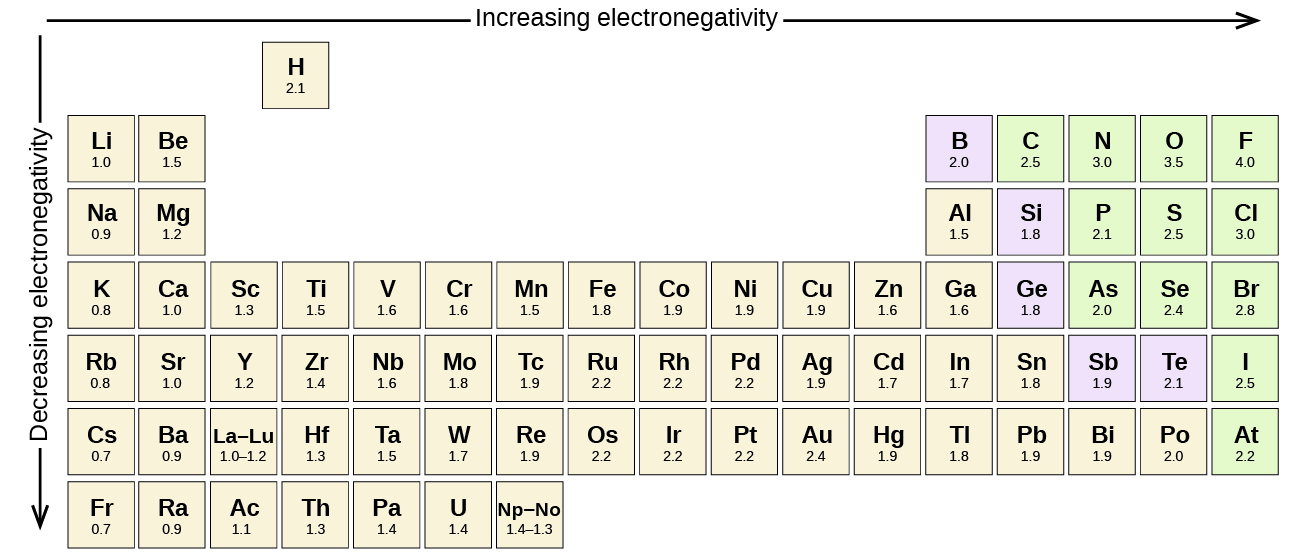
Figure \(\PageIndex{1}\): Electronegativities of the elements. Electronegativities are used to determine the polarity of covalent bonds. An interactive version of this table may be found here.
The type of bond formed by two atoms can be determined by calculating the difference in electronegativity values of the two atoms involved in the bond, as summarized in Table \(\PageIndex{1}\):
| Electronegativity Difference | Bond Type |
|---|---|
| <0.4 | nonpolar covalent |
| 0.4 – 1.9 | polar covalent |
| ≥2.0 | likely ionic |
If the difference between the electronegativities of the two atoms is small, neither atom will take the shared electrons completely away from the other atom, and the bond will be covalent. This is the case when two nonmetals are bonded to each other. If the difference between the electronegativities is large, the less electronegative atom loses the bonding electrons to the more electronegative atom (electron transfer will occur), and the bond will be ionic. This is why metals (low electronegativities) bonded with nonmetals (high electronegativities) typically produce ionic compounds.
It should also be noted that the cutoffs for the difference in electronegativity are somewhat arbitrary. Even if the difference in electronegativity was only 0.2, there were still be a hint of polar character. Electrons would not be shared entirely equally. Likewise, if the difference in electronegativity was 1.9, the bond may be defined as polar covalent, but it would also have some ionic characteristics. There wouldn't be anything "magic" that happens once that difference in electronegativity reaches 2.0. We may say it is likely ionic, but it would still have some covalent characteristics. The greater the difference becomes, the greater the ionic character.
Nonpolar Covalent Bonds
A bond in which the electronegativity difference is less than 2.0 is considered to be mostly covalent in character. However, at this point we need to distinguish between two general types of covalent bonds. A nonpolar covalent bond is a covalent bond in which the bonding electrons are shared equally between the two atoms. In a nonpolar covalent bond, sometimes simply called a nonpolar bond, the distribution of electrical charge is balanced between the two atoms.
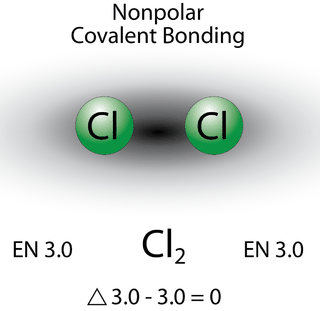
The two chlorine atoms in Figure \(\PageIndex{2}\) share the pair of electrons in the single covalent bond equally, and the electron density surrounding the Cl2 molecule is symmetrical. This is the case for any bond in which the electronegativity difference is very small (<0.4). An example would be a bond between chlorine and bromine (ΔEN = 3.0 – 2.8 = 0.2). Any shifts in electron density are too small to be noticed and the electron cloud around the nuclei is essentially symmetrical. Thus the bond is considered to be a nonpolar bond.
Polar Covalent Bonds
A bond in which the electronegativity difference between the atoms is between 0.4 to 1.9 is called a polar covalent bond. A polar covalent bond is a covalent bond in which the atoms have an unequal attraction for electrons, so the electrons are shared unequally. In a polar covalent bond, sometimes simply called a polar bond, the distribution of electrons around the molecule is no longer symmetrical.
 |
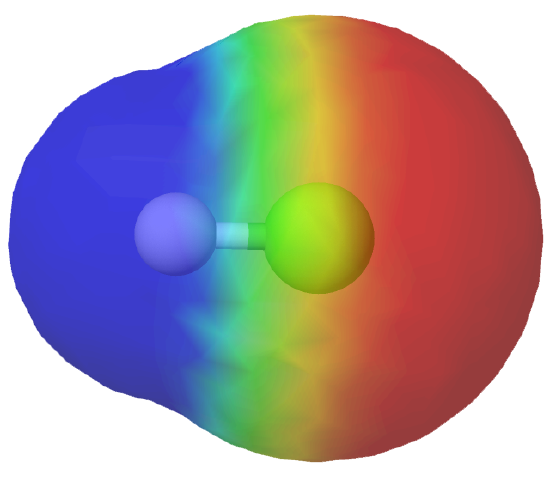 |
One way to illustrate the uneven electron distribution in a polar covalent bond is to use the Greek letter delta, δ, as shown in Figure \(\PageIndex{4}\) below. The atom with the greater electronegativity, fluorine (EN=4.0) acquires a partial negative charge (δ–), since it has a higher density of negatively charged electrons surrounding it, while the atom with the lesser electronegativity, hydrogen (EN=2.1), acquires a partial positive charge (δ+), since it has a lower density of negatively charged electrons surrounding it. The delta symbol is used to indicate that the quantity of charge is less than one.
A crossed arrow, called a dipole moment vector, may also be used to indicate the direction of greater electron density. The arrow points toward fluorine, since it has a greater electronegativity than hydrogen.

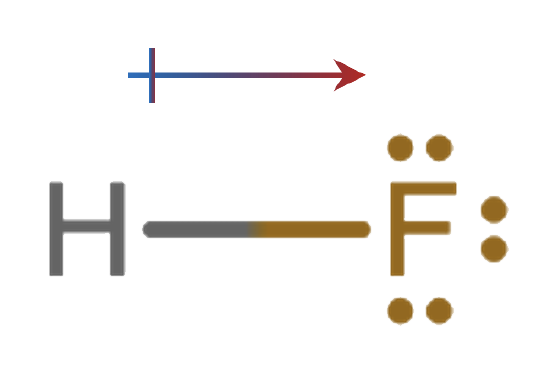
✅ Example \(\PageIndex{1}\): Bond Polarity
What is the polarity of each bond?
- N—Cl
- O—H
Solution
Using Figure \(\PageIndex{1}\), we can calculate the difference of the electronegativities of the atoms involved in the bond.
- For the N—Cl bond, the difference in the electronegativities is 3.0 − 3.0 = 0.0. Thus we predict that this bond will be nonpolar.
- For the O—H bond, the difference in electronegativities is 3.5 − 2.1 = 1.4, so we predict that this bond will be polar.
✏️ Exercise \(\PageIndex{1}\)
What is the polarity of each bond?
- Rb—F
- P—Cl
- Answer A
-
likely ionic
- Answer B
-
polar
Molecular Polarity
In addition to determining whether a specific bond is polar or nonpolar, we can also consider how all of the bonds in a molecule combine to create polar and nonpolar molecules. To determine if a molecule is polar or nonpolar, it is generally useful to look at Lewis structures. Nonpolar compounds will be symmetric, meaning all of the sides around the central atom are identical – bonded to the same element with no unshared pairs of electrons. Polar molecules are asymmetric, either containing lone pairs of electrons on a central atom and/or bonded to atoms that have different electronegativities. This distinction works pretty well, as long as you can visualize the molecular geometry. That's the hard part.
To know how the bonds are oriented in space, you should know it's three-dimensional structure and/or have a strong grasp of Lewis structures and VSEPR theory. Assuming that you do, you can usually look at the structure of each one and decide if a molecule is polar or nonpolar, whether or not you know the individual atom's electronegativity. This is because the bonds between dissimilar elements are usually polar, and in these particular examples, it doesn't matter which direction the dipole moment vectors are pointing (out or in).
A polar molecule is a molecule in which one end of the molecule is partially positive (δ+), while the other end is partially negative (δ–), as shown in Figure \(\PageIndex{5}\) below. A two-atom molecule that consists of a polar covalent bond, such as HF (shown in Figure \(\PageIndex{4}\) above), is a polar molecule. The two electrically charged regions on either end of the molecule are called poles, similar to a magnet having a north and a south pole. A molecule with two poles is called a dipole. Using this logic, hydrogen fluoride may also be called a dipole.

For molecules with more than two atoms, the molecular geometry must also be taken into account when determining if the molecule is polar or nonpolar. Figure \(\PageIndex{6}\) below shows a comparison between carbon dioxide and water. Carbon dioxide, CO2, is a linear molecule. The oxygen atoms (EN=3.5) are more electronegative than the carbon atom (EN=2.5), so there are two individual arrows pointing outward from the central carbon atom to the oxygen atoms on each end. However, since the arrows are of equal "strength" (the electronegativity difference is the same) and are oriented in opposite directions, they cancel each other out and the overall molecular polarity of CO2 is zero. This will always be the case for molecules in which all sides around the central atom are identical (symmetric molecules).
Water is a bent molecule because of the two lone pairs on the central oxygen atom. The individual dipoles point from the hydrogen atoms (EN=2.1) toward the central oxygen atom (EN=3.5). Because of the shape, the arrows do not cancel each other out; there is a net upward direction of the arrows and the water molecule is polar. In the figure below, the net dipole is shown by the arrow for the overall polarity and points upward. The inability of the arrows to cancel out is what causes molecules that are asymmetrical about the central atom to be polar.
| 3D Model | ||
| Partial Charges | 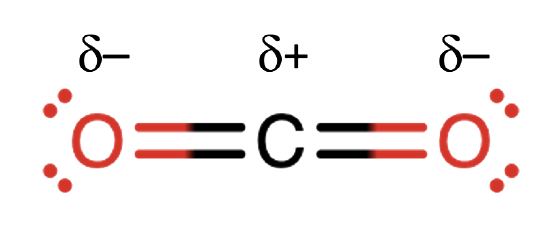 |
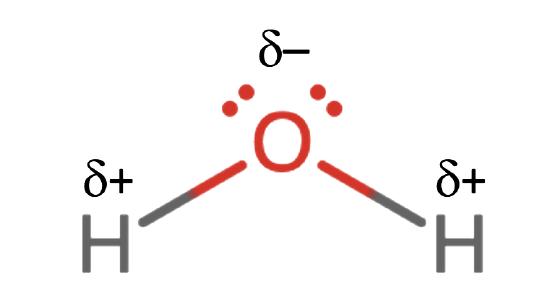 |
| Dipoles |  |
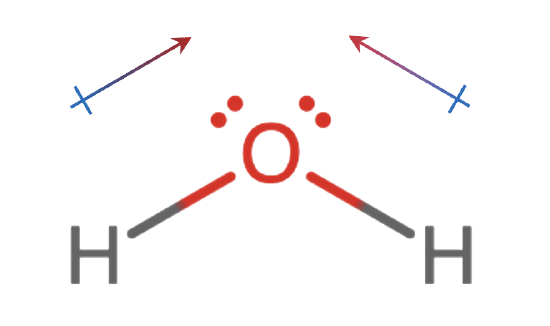 |
| Overall Polarity | arrows cancel |  |
Molecular Polarity |
nonpolar molecule | polar molecule |
It should be noted that if the all of the bonds in a molecule are nonpolar, then the molecule will be nonpolar. Consider a molecule of O2,  . The double bond between the two oxygen atoms is a nonpolar bond, since the electronegativity difference between the two atoms is zero. Since the only bond in the molecule is nonpolar, this means that a molecule of O2 is nonpolar as well. There are no arrows that can be drawn toward a more electronegative atom.
. The double bond between the two oxygen atoms is a nonpolar bond, since the electronegativity difference between the two atoms is zero. Since the only bond in the molecule is nonpolar, this means that a molecule of O2 is nonpolar as well. There are no arrows that can be drawn toward a more electronegative atom.
☞ Steps to Identify Molecular Polarity
To summarize, a polar molecule must:
- contain at least one polar bond.
- have a molecular structure such that there is a net direction of the arrows. The strength and directions of the arrows do not cancel.
✅ Example \(\PageIndex{2}\): Molecular Polarity
Label each molecule as polar or nonpolar. Manipulate molecules rendered in JSmol, if necessary, to get a better idea of their three dimensional geometry.
- Ammonia:
- Propane, C3H8:
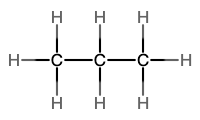
- Bromine, Br2:

Solution
- Ammonia is polar. When properly rotated, one can see that the nitrogen atom (EN=3.0) sits on a different plane than the hydrogen atoms (EN=2.1). All of the arrows point in the direction of the nitrogen atom, giving it a net direction (the strength and direction of the arrows do not cancel).
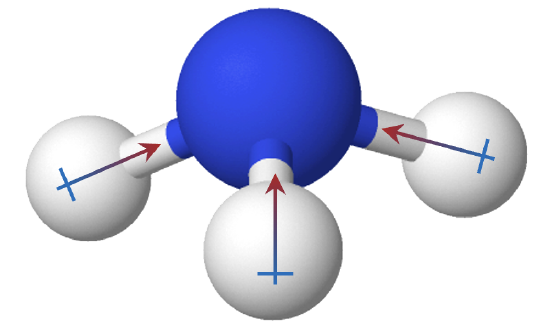
- Propane is nonpolar. This is a symmetric molecule. All of the arrows would point inward from the hydrogen atoms (EN=2.1) toward the carbon atoms (EN=2.5). The net result is that the arrows cancel each other out. In fact, this is a property of hydrocarbons – they are nonpolar molecules.
- Bromine is nonpolar. The molecule has only one Br—Br bond in which the EN=2.8 for each Br atom, so each Br atom exerts a pull on the electrons by exactly the same amount.
✏️ Exercise \(\PageIndex{2}\)
Label each molecule as polar or nonpolar.
- CCl4:
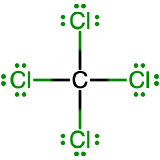
- HCl:

- Answer A
-
nonpolar
- Answer B
-
polar
Summary
- Differences in electronegativity between two atoms can be used to determine if their bond is nonpolar, polar, or ionic.
- Nonpolar covalent bonds have an equal distribution of electron density between the two nuclei.
- Polar covalent bonds have an unequal distribution of electron density with the more electronegative atom having greater electron density.
- Nonpolar molecules are formed when bond dipoles cancel each other out. This happens when the molecule is symmetrical about the central atom.
- Polar molecules are formed when bond dipoles do not cancel each other out. This occurs when the molecule is asymmetrical and contains at least one polar bond.
This page is shared under a CK-12 license and was authored, remixed, and/or curated by StackExchange (thomij), Melissa Alviar-Agnew, Henry Agnew, Lance S. Lund (Anoka-Ramsey Community College), and Vicki MacMurdo (Anoka-Ramsey Community College). Original source: https://www.ck12.org/c/chemistry/.



